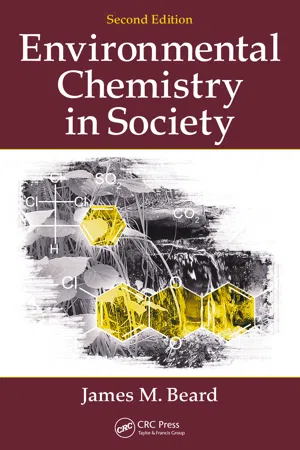
This is a test
- 409 pages
- English
- PDF
- Available on iOS & Android
eBook - PDF
Environmental Chemistry in Society
Book details
Book preview
Table of contents
Citations
About This Book
Everyone can benefit from having some understanding of environmental science and the chemistry underlying issues such as global warming, ozone depletion, energy sources, air pollution, water pollution, and waste disposal. Environmental Chemistry in Society, Second Edition presents environmental science to the non-science student, specifically focus
Frequently asked questions
At the moment all of our mobile-responsive ePub books are available to download via the app. Most of our PDFs are also available to download and we're working on making the final remaining ones downloadable now. Learn more here.
Both plans give you full access to the library and all of Perlego’s features. The only differences are the price and subscription period: With the annual plan you’ll save around 30% compared to 12 months on the monthly plan.
We are an online textbook subscription service, where you can get access to an entire online library for less than the price of a single book per month. With over 1 million books across 1000+ topics, we’ve got you covered! Learn more here.
Look out for the read-aloud symbol on your next book to see if you can listen to it. The read-aloud tool reads text aloud for you, highlighting the text as it is being read. You can pause it, speed it up and slow it down. Learn more here.
Yes, you can access Environmental Chemistry in Society by James M. Beard in PDF and/or ePUB format, as well as other popular books in Physical Sciences & Chemistry. We have over one million books available in our catalogue for you to explore.

45
UNDERLYING
PRINCIPLES
OF
CHEMISTRY
11.
Give
the
formula
for
the
compound
made
from
each
of
the
following
pairs
of
elements:
a.
Ionic
i.
Potassium
and
chlorine
ii.
Silver
and
sulfur
iii.
Iron(II)
and
iodine
iv.
Aluminum
and
sulfur
v.
Copper(I)
and
nitrogen
vi.
Sodium
and
bromine
vii.
Copper(II)
and
nitrogen
viii.
Calcium
and
chlorine
ix.
Magnesium
and
iodine
b.
Covalent
i.
Phosphorus(V)
and
iodine
ii.
Nitrogen
and
hydrogen
iii.
Silicon
and
chlorine
iv.
Iodine
and
chlorine
v.
Arsenic
and
fluorine
vi.
Boron
and
bromine
vii.
Hydrogen
and
sulfur(II)
viii.
Carbon
and
sulfur(II)
12.
Give
the
formula
for
the
compound
made
from
the
following
elements
and
poly-
atomic
ions:
a.
Sodium
and
sulfate
b.
Magnesium
and
bicarbonate
c.
Ammonium
and
chlorine
d.
Calcium
and
phosphate
e.
Iron(II)
and
nitrate
BIBLIOGRAPHY
Chang,
R.,
Chemistry
,
4th
ed.,
McGraw-Hill,
New
York,
1991,
p.
307.
Hill,
J.W.,
Chemistry
for
Changing
Times
,
6th
ed.,
Macmillan,
New
York,
1992,
p.
63.
Hudson,
J.,
The
History
of
Chemistry
,
Chapman
&
Hall,
New
York,
1992.

Table of contents
- Front Cover
- Contents
- Preface
- Acknowledgments
- Author
- Chapter 1 - Background to the Environmental Problem
- Chapter 2 - The Natural Laws
- Chapter 3 - Underlying Principles of Chemistry
- Chapter 4 - Types of Chemical Compounds and Their Reactions
- Chapter 5 - Element Cycles
- Chapter 6 - Toxicology
- Chapter 7 - Energy and Modern Society
- Chapter 8 - Weather and Climate
- Chapter 9 - Air Pollution
- Chapter 10 - Air Inside
- Chapter 11 - Global Atmospheric Change
- Chapter 12 - Water
- Chapter 13 - Water Pollution
- Chapter 14 - Solid Wastes
- Chapter 15 - Hazardous Wastes
- Glossary
- Back Cover